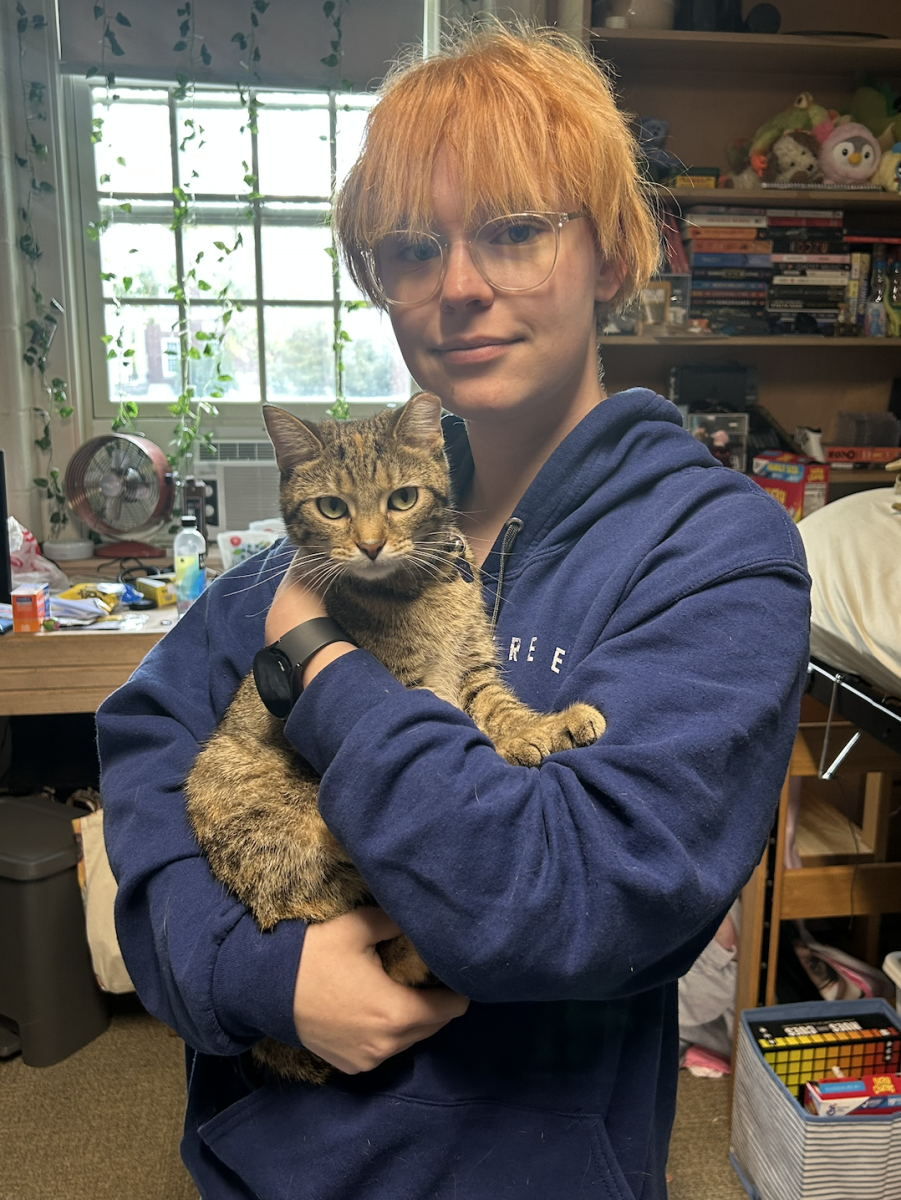Having an emotional support animal (ESA) on campus is more than owning a pet. ESAs are helpful tools for their owners and have important jobs to fulfill, even if their jobs are not always physically obvious.
Dickinson College permits students to bring emotional support animals to campus if the animal helps the student regulate their mental disabilities. John Joyce, Associate Director of the Access and Disability Services (ADS) team, said that only around 26 or 28 students on campus currently own ESAs, “around one percent of the student population.” Emotional support animals are not the same as service animals. ESAs do not receive specific, regulated training, but they still take care of their owners mostly by just being present in their owners’ lives.
Students Anjola Olubunmi Abidoye ‘28 and Madison Hensley ‘26 have their ESAs to help regulate their anxiety and Chris Vill ‘26 has his cat to help him control his mood and inspire him to do everyday tasks. All three students agree that their ESAs help maintain their mental health by simply giving them something to take care of, which motivates them to take care of themselves, too. Hensley says that having a pet is a big responsibility. She says that she’s forced to “take breaks with [her cat] to ease [her] stress and in general help with [her] anxiety.”
Abidoye explains a similar scenario: “Sometimes I don’t want to leave my room. Sometimes I don’t want to go to the Caf and get something to eat because I just feel very apathetic,” but her dog “forces me to go outside to take her on walks. And then feeding her makes me be like, okay, I shall behave myself.” She says that she and her dog, Angel, have a “symbiotic relationship; we help each other.” Vill ‘26 has a similar relationship with his cat, Kermit, and says that “it’s just great having something else to care of in college other than yourself. I think that’s what really helped me.”
Hensley and Vill both mention how their close relationships with their cats gives their pets the ability to “just [be able to] tell” when their owner is going to have a panic attack or when they are stressed out in general.
Abidoye says that Angel will “pic[k] up on warning cues” when she is about to have a panic or asthma attack. In the case that she is about to have an anxiety attack, Angel “will literally step in and stop me from doing whatever I was doing”.
The pets naturally provide physical comfort to their owners and encourage them to release their emotions in a healthy way.
Vill ‘26 and Hensley ‘26 agree that the physical touch aspect of owning their cats and being able to hold them in their arms makes a big difference for them. Vill ‘26 says Kermit’s physical presence is really grounding for him during emotional moments.
Joyce mentioned that when a student requests to bring an ESA to campus with them, he must inform them that doing so “[will] automatically identif[y] them as a person with a disability to others,” just so they are aware. He says that when others know that a student has an ESA, it can “help [students with ESAs] create community with students who don’t have ESAs” since the others will likely ask the ESA owner to see their pet. Abidoye describes Angel as a sort of “icebreaker” that helps her start conversations with other students.
“I was living in Adams and it just spread everywhere that I had a cat” says Hensley ‘26. She likes it when people see that she has a cat and ask to meet her. It makes her feel good that she can make people happy when they are missing their own cats, or just want some cuddly love. “It’s definitely been a big way to bring myself out of my shell,” she said.
But Hensley also says that being known for her ESA “has its pros and its cons at the same time.” She says it can be frustrating when people who visit the cat aren’t interested in making genuine connections with Hensley as a person. “If you’re not going to talk to me outside of my room in the dorm, then it gets a little bit irritating,” she said.
Abidoye is also widely known on campus for Angel, and she says it doesn’t bother her when people ask to meet Angel, but she says that during her freshman year, people would cross a line by “want[ing] to know what was wrong with me, which I am not typically [comfortable] with sharing.” When curious people aren’t “investigatory” in this way, she says that she’s happy to let them say hi to Angel or answer their questions about owning a dog on campus.
While Abidoye ‘28, Hensley ‘26 and Vill ‘26 all have conventional household pets, Joyce explains that ESAs can come in unexpected forms. He imagines that it might be hard for someone to understand how a reptilian animal, for example, could be a source of support for someone struggling with their mental health. But “it doesn’t really matter if they don’t understand how it’s a support, because it’s unique to the person’s needs and what support they drive from [it].” He suggests that those animals may “provide tactile support because what is supportive [to that individual] is not cuddling with something fluffy, but [rather] being able to touch something that’s rough.”
Students should avoid making assumptions about students who have ESAs. Hensley ‘26 explains how some students assume that she “used resources to manipulate the system… because I wanted to bring my cat with me.” She says “that’s definitely not the case [and] ESAs are a thing for a reason…I really do feel like I depend on her for a legitimate medical or mental reason”, even if it may not be totally apparent to the typical observer,” she said.
Vill ‘26 notes that Kermit is not like any other pet. He says that they have a “different connection” that’s unlike the usual pet/owner relationship. ESAs are not just pets, they are working animals that have the important job of always looking after their owners.
If you or someone you know is interested in bringing their ESA to Dickinson, reach out to ADS or visit their page on the Dickinson Website.






